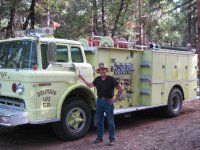Ken45101
Elite Member
- Joined
- Feb 14, 2009
- Messages
- 3,655
- Location
- southern Ohio
- Tractor
- Kubota M5040, M9540, B21 TLB, B2710, RTV900, JD 325 Skid steer, KX-121-3 mini excavator
I have found 2.5 gallon air pressurized extinguishers far superior than the ABC units, I have the foaming nozzle on the extinguishers, and even adding some dawn dish soap will do wonders, to the effectiveness of the extinguishers, look up cold fire and watch there videos,
I agree! Dry chemical extinguishers are for grease and oil fires, not wood/plastic/paper. Looking at a typical small dry chem extinguisher, it is rated at 1A:10BC. The A rating is miniscule. I much prefer the pressurized water extinguishers but they are not for kitchen stove fires!!
